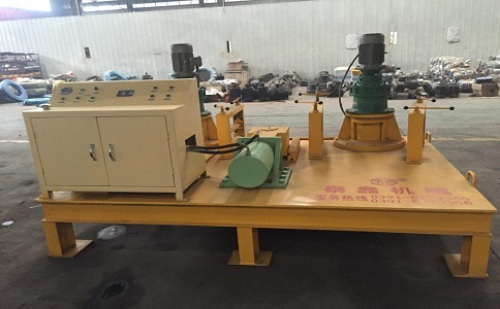Introduction: WGJ series I-beam bending machine, alias is also called cold bending machine, I-beam bending machine, channel steel bending machine, I-beam cold bending machine This I-beam bending machine is of mechanical type, hydraulic type and numerical control type. Each has its own characteristics: hydraulic type adopts hydraulic transmission, which has stable transmission, high pressure, accurate positioning, high processing precision, and processing. The speed is greatly improved and other features; mechanical type, it is to change the original hydraulic system to the jack system, in order to facilitate transportation and handling under complex conditions, the volume and weight have also been adjusted, the whole small and exquisite, the function is Increased unabated, its speed can be adjusted through a continuously variable transmission, convenient and reliable;
We can supply big range of such ironcasting
parts, including investment casting and Sand Casting.
In metalworking, casting involves pouring
liquid metal into a mold, which contains a hollow cavity of the desired shape,
and then allowing it to cool and solidify. The solidified part is also known as
a casting, which is ejected or broken out of the mold to complete the process.
Casting process simulation uses numerical
methods to calculate cast component quality considering mold filling,
solidification and cooling, and provides a quantitative prediction of casting
mechanical properties, thermal stresses and distortion. Simulation accurately
describes a cast component`s quality up-front before production starts. The
casting rigging can be designed with respect to the required component properties.
This has benefits beyond a reduction in pre-production sampling, as the precise
layout of the complete casting system also leads to energy, material, and
tooling savings.
The software supports the user in component
design, the determination of melting practice and casting methoding through to
pattern and mold making, heat treatment, and finishing. This saves costs along
the entire casting manufacturing route.
B.
Main particulars
MAIN
PARTICULARS
Material for product
Cast iron(like QT, HT-)
Standard
ASTM, ASME, DIN, JIS,
ISO, BS, API, EN
Certificate
ISO9001
Dimension
As
per drawing, as large as we can
Processing
Step1:investment casting or sand casting
Step2:turning, milling, drilling,
grinding, threading, CNC Machining, boring
Finishing
surface
Machined
surface with oil, blasting and painting, anodize, polishing, powder painting,
electrophoretic coating-
Marking
as
per clients` requirements
Inspection
material,
construction, dimension, heat treatment, hardness, NDT
Quality
ISO9001,
PPAP control production
Lead
time
20-30
days for sample, consult with customer for mass production
Delivery
Express
for sample, ocean shipping/air for mass production
Our
Capabilities
CNC
machining, CNC center machining, drilling, milling, turning, grinding,
tapping, boring
Engineering
& manufacturing services
R&D
process, tooling and gauging design, product design
Integrated
CAD/CAM system, test and measuring
Others
Recyclable,
in line with environmental requirements and standards, and reliable
C.
Construction
Construction
by casting and machining
D
Workmanship
The
workmanship have good production practice. Care are taken to ensure High
accuracy and smooth surfaces
E.
Certificates
-
Material certificates
-
Measuring reports
-
Inspection protocol
-
NDT reports
-
Fixed certificate: ISO9001 certificate
Our
service
Besides
above the general specifications, we can also supply some specific machining
parts as clients' requirements.
Package
and shipping
Export
cartons, pallets, wooden cases, Polybags
container
package and container transportation
Iron Casting Parts,Oem Iron Casting Parts,Iron Sand Casting,Sand Casting Metal Parts Shinvast Industry Ltd , http://www.shinvastindustry.com
CNC curved arching machine has three obvious features:
1) Control: PLC program controller is used to automatically read data from the full hydraulic system;
2) Operation: unlimited feeding, can be advanced or retracted, the cylinder can be automatically positioned without manual measurement, automatic bending radius reading;
3) Security: Double automatic shutdown system, automatic shutdown at the specified size, infrared control system, automatic shutdown when there is no material.
In fact, whether they are mechanical type, hydraulic type, or numerical control type, they are also applied to tunnels, subways, hydropower stations, underground caverns, etc. I-beams, channel steel bending.
Correct operation of I-beam bending machine
1. The required cold-formed steel is pushed between the two driving rollers of the cold bending machine by the door bracket of the auxiliary system;
2. Start the hydraulic system of the cold bending machine so that the hydraulic cylinder pushes the dovetail groove and the cold bending roller cold-pressed steel;
3. When the arc required for the design is reached, the hydraulic system of the cold bending machine is turned off, the drive system of the equipment is started, the active roller is rotated, and the type steel is driven by friction to move forward steadily and slowly so as to realize continuous cold bending operation;
4. At the end of cold bending, the hydraulic system of the cold bending machine is started while the drive system of the equipment is turned off. The cold-formed steel is placed on the door bracket of the auxiliary system.
I-steel bending machine maintenance:
Curved arch machine in daily life needs to do a full range of maintenance, only the maintenance is good, in order to ensure the normal operation of the equipment, then we need how to maintain, here's a brief introduction to its maintenance precautions:
1. Before use, you must first perform a no-load trial to understand the operation buttons and limit the technology.
2. Check the lubrication of each component before use and refuel when necessary.
3, carefully understand the instructions, in strict accordance with the instructions for use.
4. Clean up the residue in time during use to avoid affecting the use.
5. Do not place anything on the surface of the machine and its surroundings during operation to prevent accidents.
6. Abnormal conditions found during use must be shut down, and the operation can only be continued after clearing the fault.
7. During operation, if you need to reverse, you must first stop, and then reverse the work.